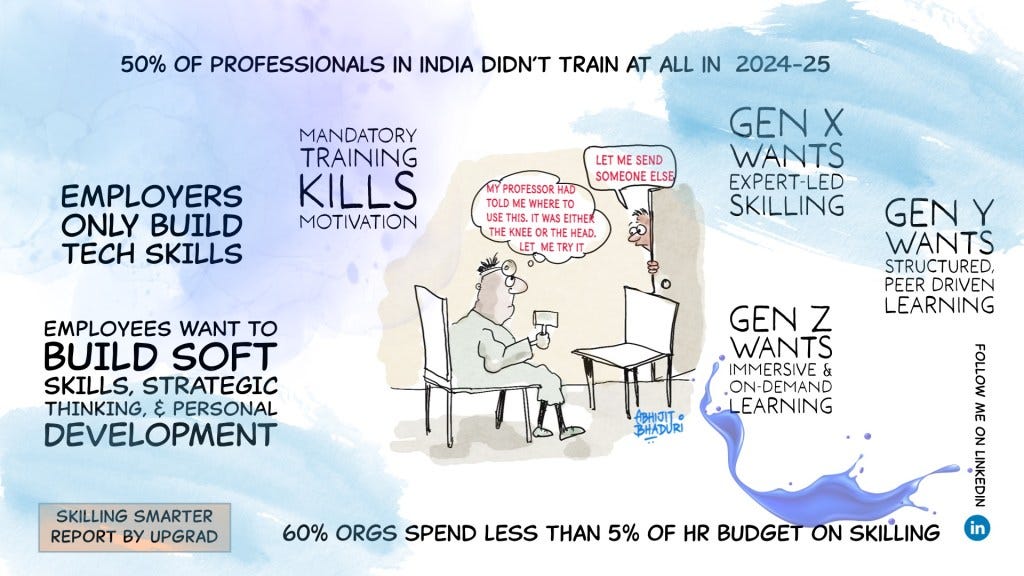The Fault Lies In Our Defaults
You button your shirt in the same sequence. You wear the same shoe first. Once a behavior sets in, we do it without actively thinking and evaluating it.
I’ve been using an iPhone for over a decade. It works beautifully. But if I’m honest—I’ve never changed the ringtone or the default alarm. I still use the default browser.
Not because I love these settings. But because they were already there. And that’s the thing about default settings—they quietly shape our choices. Steve Jobs understood this. He didn’t just build products. He designed behavior. He knew that if something was the default, most of us would leave it alone.
Which brings me to a question I can’t stop thinking about – why do we not question the default settings of the workplace.
Many HR systems were designed for a different workforce
More than 50% of the global workforce is now millennial or Gen Z, yet many HR systems still assume a one-size-fits-all approach to motivation. Women’s workforce participation is rising—but caregiving policies remain outdated. In India, over 90% of workers are in the informal sector, yet most engagement tools are built for office-based employees. Skills now have a shelf life of less than three years, but performance reviews still run on annual cycles. The workforce has changed—but our defaults haven’t.
So many things have changed around us in the last few years. That means we need to update the data, opinions and assumptions. Here are a few shifts that stumped me. Can you guess the country with the highest proportion of women engineers? And while you are at it, guess which country has 55% women in the entire science & engineering workforce? (Answers at the end of the newsletter)
In the next five years 1-2% of India’s total workforce (ie 23 MILLION people) will be gig workers. Women ages 15–35 make up approx 52% workforce in India. The workforce has changed. How we work, when and where we work has changed. It is time we reimagined HR.
1. Women Now Constitute Over Half of the U.S. Workforce
2. There is a shift in retirement patterns and workforce demographics.
3. Gig Economy in India will be approx 23.5 mn in 2029-30
4. Job-Hopping is a career advancement strategy
5. Skills Lifespan Shortening Rapidly
How are old assumptions even valid?
In the last five years, we had a pandemic, geopolitical balances have changed, the climate problems are showing up everywhere and yes the girl child is being welcomed in more societies. The Economist dated June 7-2025 says there are many reasons why that shift is happening. 93% of the jail inmates are men and in rich countries 54% of women are getting a tertiary education while only 41% men are studying that far. But we keep HR systems designed for the old world we inherited.
Things that have changed & I have not noticed
Even information that was assumed to static - eg the number of planets in our solar system have been questioned and have undergone multiple iterations. It is not surprising that I have missed tracking these changes that are given below.
1. What is the literacy rate in India as of 2024 (age 15+ who can read and write)?
A. 68%
B. 74%
C. 82%
D. 91%
2. Which Indian state sends the highest number of migrant workers abroad?
A. Punjab
B. Uttar Pradesh
C. Kerala
D. Tamil Nadu
3. What percentage of all global software engineers does India contribute?
A.
4. Which country received the highest remittances in 2023?
A.
5. What is the leading cause of stomach ulcers globally today?
A.
Many of today’s HR practices were designed decades ago—some more than a century back.
Jobs were permanent
People stayed for 30 years
Careers moved only upward
Learning was an event
Feedback came once a year
The Workforce Has Changed, Not The Default Assumptions
According UpGrads recent report on Skilling we don’t do enough to invest in people’s skills.
Most HR systems still run on defaults that haven’t been questioned in decades. We assume
Everyone will log into the LMS on their own
Managers will ask for feedback without being nudged
Employees will apply for internal roles they’ve never seen
People will grow just by waiting
These aren’t talent gaps.
We must build systems that assume participation—then give them the freedom to opt out. For example: Auto-enroll in a default learning path every week. Then share how the peers have progressed.
Here are default settings you can question
1. Onboarding Content Still Frozen in the Past
What’s outdated: Many onboarding decks and e-learning modules still refer to COVID protocols, outdated office floor plans, or previous leadership teams.
What’s missing: Current hybrid work norms, updated business priorities, and recent leadership transitions.
2. Performance Reviews Built for Another Era
What’s outdated: Annual reviews based on static goals, with outdated competency models.
What’s missing: Real-time feedback loops, AI-assisted coaching nudges, recognition of gig/remote/contract work contributions, and team-based assessments.
3. Learning Content Is Stale or Irrelevant
What’s outdated: LMS platforms miss updating content that builds AI fluency or climate impact awareness.
What’s missing: Speed of response. Content aligned to new leadership, updated company values, business strategy shifts, or emerging technologies like GenAI. And it is not built with velocity.
And that’s exactly why we need to keep updating not just our skills, but our understanding of people. Because talent strategies built on yesterday’s assumptions simply won’t work for today’s irrational, changing, and wonderfully complex humans.
Why We Stick to the Default: Status Quo Bias and How It Shapes Talent Decisions
Now think about signing up for a newsletter. If the box is pre-checked to receive updates (opt-out), most people stay subscribed. If the box is empty and you have to tick it yourself (opt-in), far fewer people do. That’s the power of
To break this bias, design talent systems that default to progress. Make peer feedback a default step in reviews. Auto-enroll new hires into mentoring programs, with the option to opt out. The structure of the choice—not just the quality of the offer—can determine whether people grow or stay stuck. Do you agree?






Absolutely agree! Specially the last point about how we as HRs should inbuilt and optimise the feature of “Default” into driving change in evolving organisations.
Thank you for sharing this. Really made me sit back and think what all I have been doing in my default system.
Definitely gonna tweak my strategy as well after reading this article.